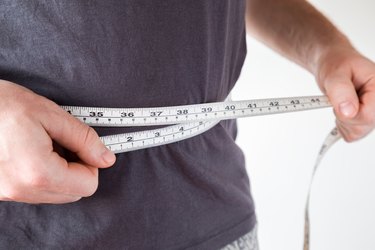
Weighing yourself may not be a part of your daily routine. But surely you are getting dressed every day — and trousers that won't button or that you've outgrown altogether red-flag a weight gain. In fact, your waistline can tell you more about your health than the numbers on the scale can.
BMI vs. Waist Circumference
Video of the Day
Many people look to their body mass index (BMI) as a way of determining whether they're overweight. Your BMI is your weight in kilograms divided by your height in meters.
Video of the Day
A high BMI of 25 or above can indicate high body fat, but it isn't always accurate because a high BMI could actually mean high lean body mass (muscle).
To get a better picture, look at your waist circumference. Even if your BMI is in the healthy range, having a big belly — as indicated by a large waist — could mean your health is at risk.
Read more: BMI Vs. Body Fat Percentage
Measure Your Waist
Don't look to your jeans size as an accurate idea of your waist circumference. Instead, follow advice from the Mayo Clinic on how to accurately measure your waist:
- With a bare stomach, stand up straight and put the tape measure around you just above your hip bone, keeping it level all the way around.
- Pull the tape so it's snug but not digging into your skin. Resist the urge to suck in. Instead, relax and exhale.
If your waist measurement is greater than 40 inches (102 centimeters), you're carrying too much belly fat.
Hip and Height Ratios
In addition to looking at one measurement, there are a few waist circumference calculators you can use. You can get an even better understanding of your waist circumference by measuring it against your hip circumference or your height.
Waist-to-Hip: Measure your hips at their widest area (usually around your buttocks), and divide your waist circumference by your hip circumference. As noted by the MD Anderson Cancer Center, men should have a waist-to-hip ratio of less than 0.95.
Waist-to-Height: Divide your waist circumference by your height using the same unit (inches divided by inches, or centimeters divided by centimeters). A study published by PLOS One in September 2014 shows that you should keep your waist circumference at half of your height and that a waist-to-height ratio gives a better indication of health than BMI alone.
Examining Other Methods
You may be worried not so much about being overweight but, rather, about possibly being underweight. Your arm measurement can be helpful as a marker of malnutrition. A mid-upper arm circumference (MUAC) of less than 22.5 centimeters (8.9 inches) relates to a BMI of less than 18.5 and indicates that you're underweight.
Read more: Arm Circumference & BMI Comparison
Striving for Perfect Measurements
There are no perfect measurements for anyone, but men should be able to glean from this information that indicators of good health are having a MUAC greater than 22.5 centimeters (8.9 inches) and a waist circumference less than 40 inches. It's important to note, according to Mayo Clinic, that men with waists of 43 inches or greater have a 50-percent higher mortality rate than those with waists that measure under 35 inches, and that for, every 2-inch increase in a man's waist circumference, his mortality risk increases by 7 percent.
Read more: How Guys Slim Down in Waist Size
A health care professional can help you better understand your body composition, but these measurements, combined with your BMI, can serve as a general guideline.
- Centers for Disease Control and Prevention: "Body Mass Index (BMI)"
- Centers for Disease Control and Prevention: "About Adult BMI"
- Mayo Clinic: "Large Waist Linked to Poor Health, Even Among Those in Healthy Body Mass Index Ranges"
- MD Anderson Cancer Center: "Drop Belly Fat, Drop Cancer Risks"
- PLOS One: "Relationship Between Mid-Upper Arm Circumference and Body Mass Index in Inpatients"
- PLOS One: "Waist-to-Height Ratio is More Predictive of Years of Life Lost than Body Mass Index"